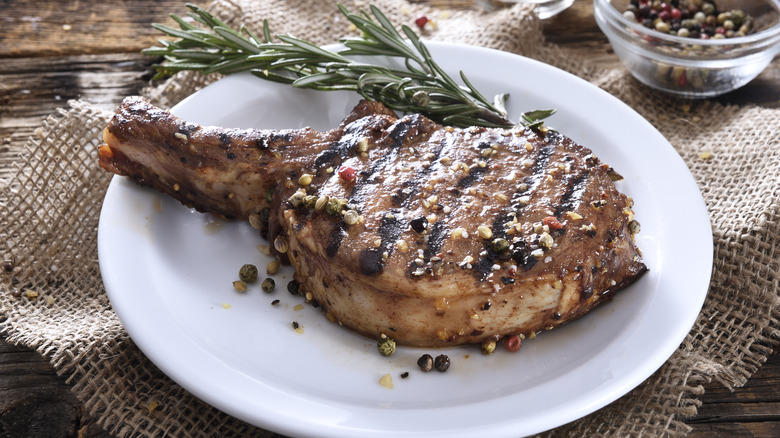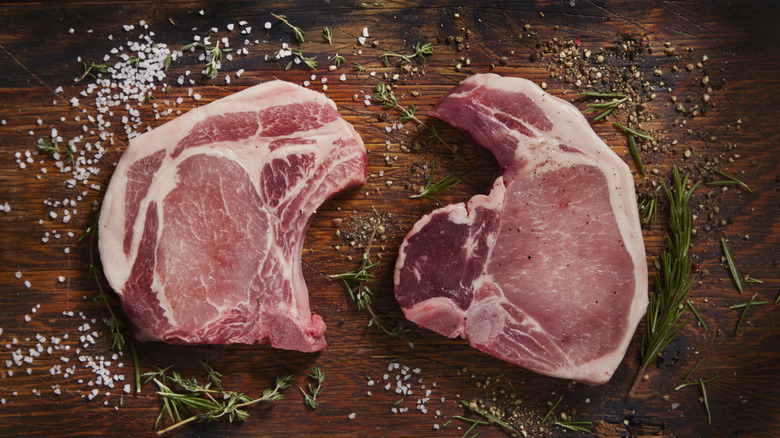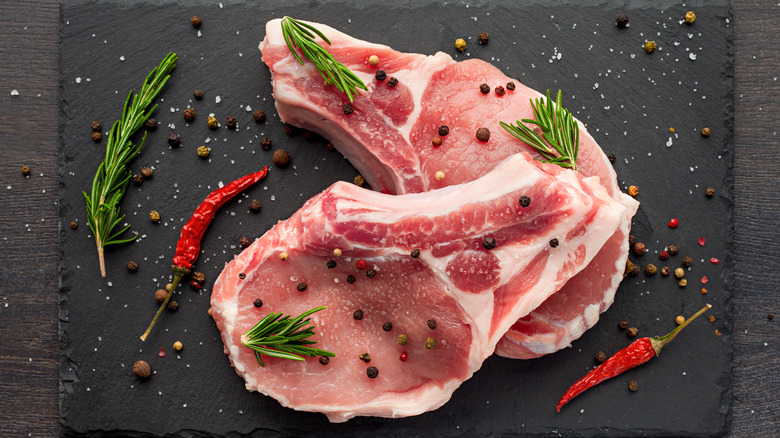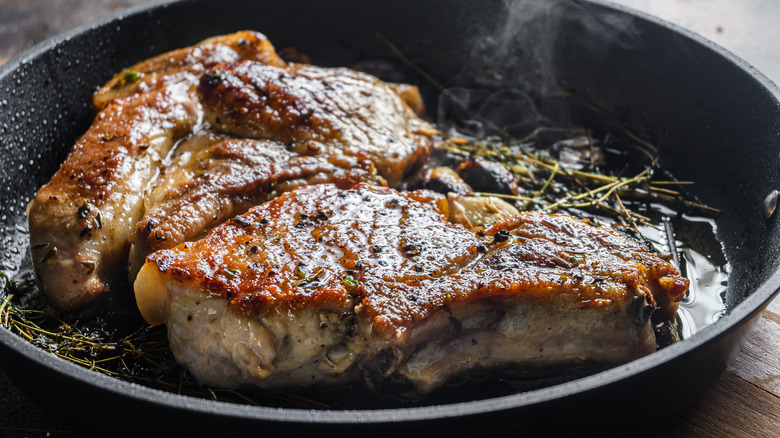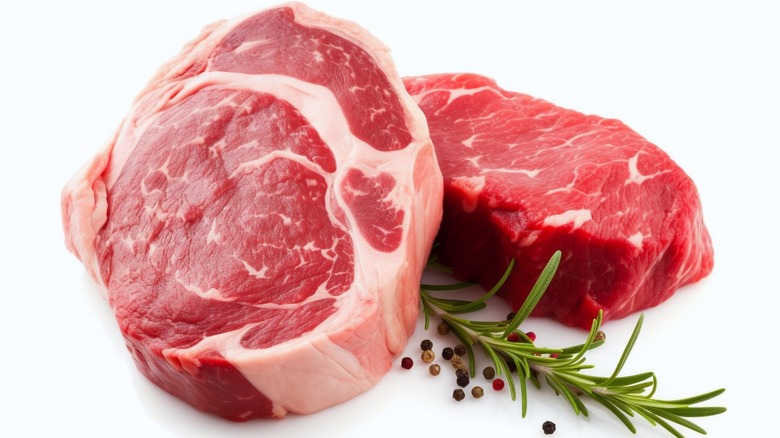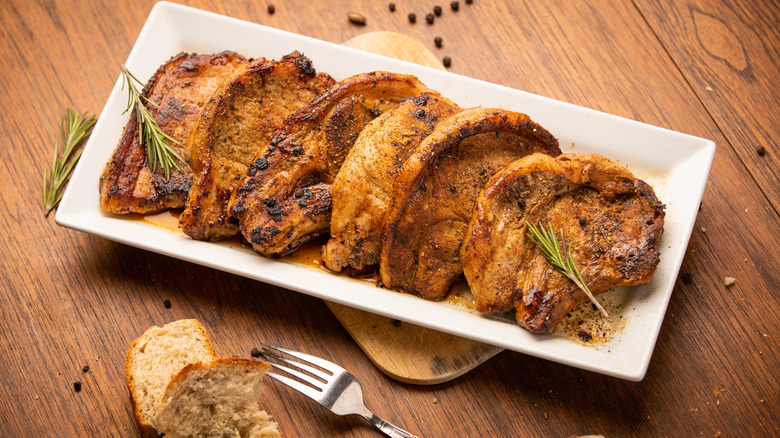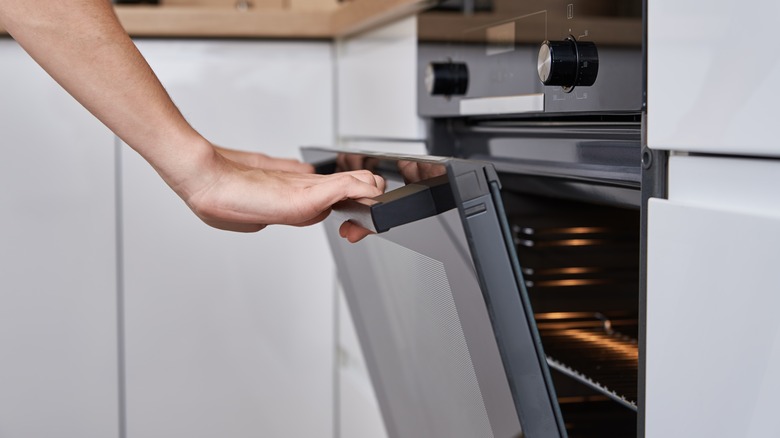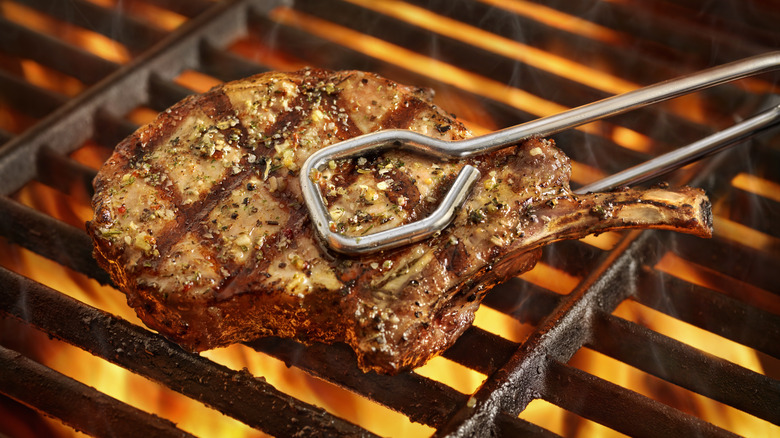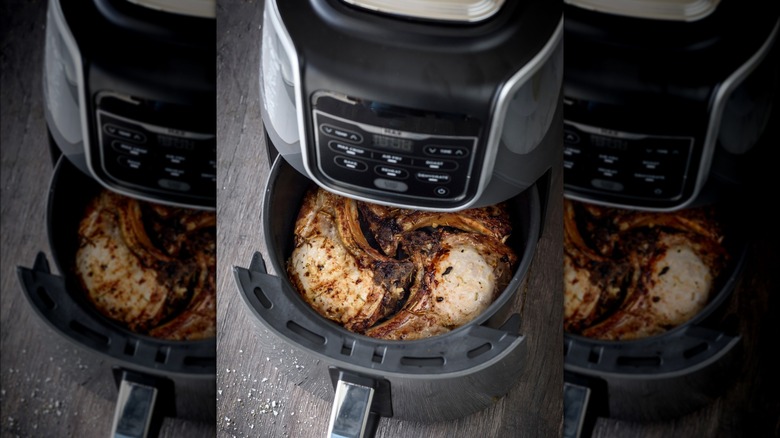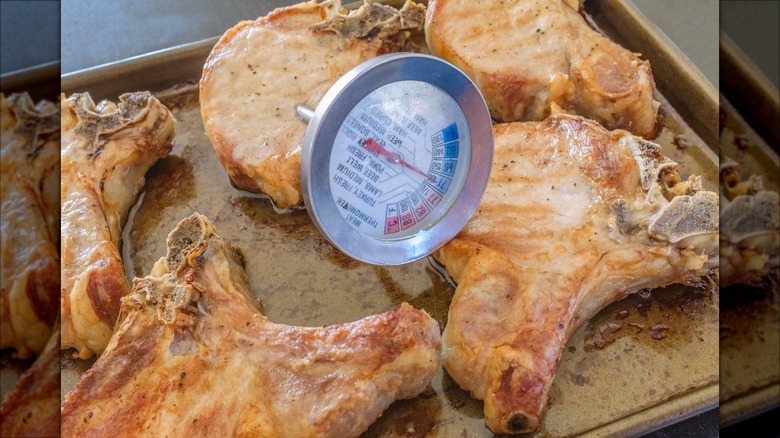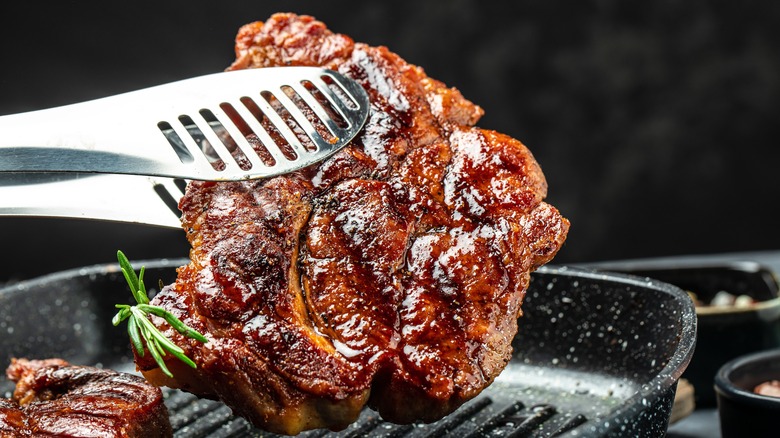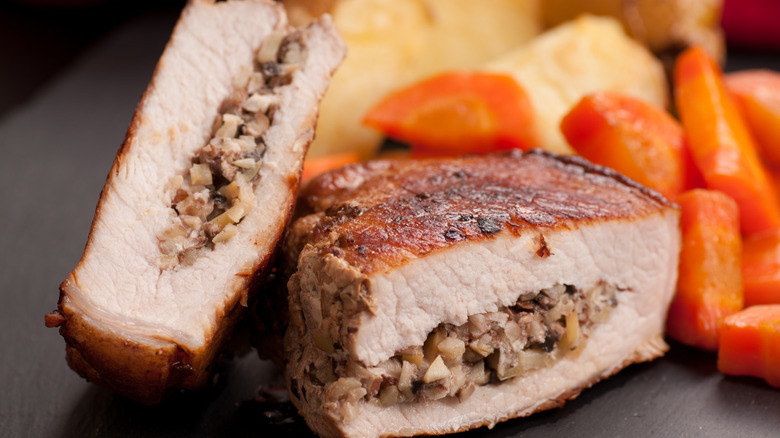11 Mistakes Everyone Makes When Cooking Pork Chops
Pork chops can make a delicious lunch or dinner. They pair beautifully with a range of side dishes — including salads, mashed, roasted, or baked potatoes, steamed green beans, roasted Brussels sprouts, cornbread, and so many others. Whether you cook pork chops regularly, only make them for special occasions, or are looking to prepare them for the first time, there are several common mistakes you'll want to avoid.
While preparing pork chops is not as involved as some other types of meat, it is far from fool-proof. Some seemingly minor missteps could spell major trouble for the meal. A blunder could end up sabotaging the taste, throwing off the texture, or impacting the overall quality of what you're dishing up. If you want to learn more about these common mistakes when cooking pork chops and the catastrophes that they can cause, keep reading. Then, you'll be armed with the knowledge you need to avoid making them yourself.
Not buying bone-in chops
If you typically purchase boneless pork chops, then you've just identified the first mistake you've been making. While there are a few benefits to boneless varieties, including the fact that they cook more quickly and have less fat, the downsides outweigh these pros. The biggest reason to choose bone-in pork chops comes down to the flavor, which is what we're all looking for when cooking meals. The higher fat content in the meat means that they tend to turn out much tastier. The fat also helps increase the moisture content, preventing the pork from drying out too much.
Bone-in pork chops are often a more budget-friendly option as well (though this may depend on the specific cut and whether they are Frenched). There is also just something attractive about serving a pork chop still on the bone. It looks more professional and like something you'd get from an upscale restaurant. If you pay the extra to have the bones Frenched (having the butcher cut away all the excess meat and fat right along the edge of the bone), it can look even more elegant.
Improperly seasoning them
The right cut of meat will go a long way in delivering the best flavor. However, you must also season your pork chops adequately to get an incredible taste out of them. Pork is a mild meat. If you want to enhance the natural flavor, always season with a little salt. Just take care not to salt the meat too much ahead of time. Salt absorbs moisture, so sprinkling it on too far in advance can result in a dry finished product. You also want to take care to evenly salt the meat. Otherwise, some bites will be saltier than others. Holding your hand 10 to 12 inches over the chops when sprinkling the salt can help ensure more even distribution.
While you could stick with just salt (or a little bit of pepper as well), there are many other seasonings you can add to pork chops. The best seasoning to use will vary, depending on your taste preferences, who else you're preparing the food for, and the side dishes you're planning for the meal. Rosemary and garlic both taste amazing with pork — either on their own or when combined together. Consider sprinkling some fresh rosemary and chopped garlic over the meat and drizzling some oil over it before baking. If you want something with a little more of a kick, consider trying paprika or cayenne pepper mixed with garlic powder, onion powder, and a little brown sugar for a touch of sweetness.
Cooking them right out of the refrigerator
Never grab your pork chops from the refrigerator and stick them directly into a hot pan — or a hot oven — to cook. Instead, you must let the chops warm up to about room temperature before cooking them. When pork chops are removed from the fridge, they're as cold as you have it set, typically somewhere around 40 degrees Fahrenheit. If you don't let them sit out for long enough, the outside is going to warm up much more quickly, which means it will cook faster than the inside. The result could be an overly-cooked exterior with an interior that is still not fully cooked.
Leaving your chops out for 30 to 45 minutes should be enough to bring the meat to room temperature. Spread the chops out into a single layer to ensure they warm up evenly. Adding this small step to your cooking routine will help ensure that the inside and outside cook more evenly, leaving you with a more tender piece of meat that isn't dried or overly-charred.
Not scoring the fat
When you've cooked pork chops in the past, have they ever curled up in the pan or turned out looking all shriveled up? This is something you'll want to avoid, as the chops will not be as presentable when served to your dinner guests. Fortunately, there is a simple trick that can help you prevent this problem: score the fat.
Scoring the fat allows the meat to relax, and means that the pork won't curl up when you cook it. If you're not familiar with how to score fat, it is a simple process. You'll only need a cutting board and a sharp knife. Hold the pork chop fat side up and use the knife to slice into the fat. Make multiple cuts along the perimeter of the fat strip, about an inch apart. Repeat this process for all the pork chops you want to cook, and they'll be ready to put in the oven or pan.
Never brining pork chops before cooking them
Did you know that you can brine pork chops? Much like brining a turkey, brining pork shops helps you create a moist and juice entree. It can help you steer clear of those overly dry or chewy chops that no one wants to eat.
A wet brine involves mixing water and salt together — and other seasonings or even sugar, if desired. The pork chops are soaked in the brining solution for about 30 minutes (or the equivalent of 1 hour per pound). The reason brining works is because it infuses the meat with some extra moisture. Pork always loses some moisture when it cooks, but with the higher starting level, it will still remain moist when it is brined first. The salt in the brine is the other reason why this method is effective. The salt works to break down the proteins in the meat, tenderizing it.
Putting them in a cold oven
If you're baking your pork chops, one mistake you'll want to avoid is putting them in a cold oven. You should always factor in enough time to let the oven preheat to the temperature your recipe calls for. If you put the pork chops into a cool oven, they aren't going to cook properly. The overall cooking time will be increased because they'll initially cook slower than expected because of the lower oven temperature.
If you prefer the outer portions of your baked or breaded pork chops to be crispy, then there's another reason you'll want to be sure to put them into a preheated oven. A hot oven is necessary to really get the texture right for bread crumbs or just the outside of the meat. You'll end up sorely disappointed when you remove the chops from the oven if you were hoping they'd come out pleasantly browned with a crisp crust.
Overlooking the grill for pork chops
Two of the most common ways to cook pork chops are in the oven or on the stovetop. And, while there is certainly nothing wrong with either of these methods, you'll be missing out if you never try preparing pork chops on your grill. If you love the smoky flavor associated with cooking over a fire, then you'll love the way grilled pork chops taste. They're flavorful, juicy, and delicious, the perfect accompaniment for a backyard barbecue.
To help make sure your grilled pork chops live up to their potential, it is important to choose the right cut of meat. Only use bone-in varieties if you want to make sure that they don't end up overly dry. For this reason, it is also best to grill thick chops instead of thinner ones. Thin cuts (less than 1 inch thick), will cook too quickly and are more likely to end up dry in the center. Before grilling your pork chops, you will also want to marinate the pork to help ensure they turn out moist and flavorful.
Not trying to cook them in the air fryer
The air fryer is another cooking tool that you shouldn't overlook when preparing pork chops. There are numerous benefits to air frying foods. These cooking tools allow you to cook using less fat (like cooking oils or butter), leaving you with lower-calorie meals. Because of the way the air circulates within the cooking area, foods still turn out nice and crispy. With an air fryer, cooking times are often reduced, so you can get your pork chop dinner on the table faster on a busy night. The air fryer expels less heat into your kitchen than an oven, so it might be a better option on a hot day when you don't want to turn on the oven.
Cooking pork chops in your air fryer allows you to take advantage of all of these benefits. The pork chops will come out tender and juicy. You can try any of your favorite seasonings or marinades in your air fryer. It may also be a good place to try making breaded pork chops, as you won't need to use much — or any — oil, and the breading should still turn out crispy and crunchy.
Under- or overcooking them
Being able to identify when your pork chops have finished cooking is essential. No one wants to be served pork that is still cold or raw in the middle, but they also don't want to be forced to eat a chop that is overcooked, dry, and chewy. We all know that chicken should never be pink inside, so it is easy to understand why you might try to apply this same rule to pork. After all, many of us grew up hearing that "pork is the other white meat." However, unlike chicken, pork chops may still be slightly pink on the inside when they're fully cooked. And, trying to keep cooking them until there is no pink left could leave you with a dry and overcooked disaster.
Pork chops should release some clear juice when they're poked with a knife. This is one way to tell that they've finished cooking. However, it is still recommended to use a meat thermometer to confirm that the meat has reached a safe internal temperature. The USDA recommends cooking pork chops to a minimum internal temperature of 145 degrees Fahrenheit, followed by at least a three-minute rest to let the meat continue cooking a bit more.
Forgetting to let them rest after cooking
When you remove a pork chop from the oven, skillet, air fryer, or grill, it can be tempting to cut into it immediately. You want to taste the result of all of your hard work. However, now is the time to exercise just a little more patience, knowing that the end result will be worth it. Pork chops must be allowed to rest for at least three minutes, as the USDA recommends, to let them continue cooking for a few additional minutes.
Beyond this, you also need to let the roast rest to help it retain all the juices and moisture it holds. If you immediately cut into a pork chop after cooking it, the juices will rush out of it. This will leave you with a dry and undesirable piece of meat. When you let the meat rest for a few minutes, it will reabsorb the juices. Then, when you cut into it a few minutes later, each bite will be moist and delicious. The ideal rest time will vary based on the size of the chop you have. As a general rule, aim to give your pork chops about half of their cooking time to rest (so about 12 to 13 minutes for a thicker chop that took about 25 minutes to cook).
Not trying stuffed pork chops
There is absolutely nothing wrong with cooking your pork chops and serving them with your favorite sides. However, don't make the mistake of never trying stuffed pork chops to let your taste buds experience the magic that happens when the meat is filled with other flavorful ingredients.
There are many stuffed pork chop recipes out there with different flavor combinations to explore. You can stick with something more basic, such as some cheese and breadcrumbs or try something with more of a kick, like jalapeño peppers, gouda, and bacon. Experiment with some of your favorite seasonings and ingredients to find a combination that is certain to delight with each bite. When preparing stuffed pork chops, you'll want to start with a thicker-cut pork chop to make sure you have space to add the filling. Cut a deep pocket in each chop using a sharp knife. Just take care to avoid making it so deep that you cut through the other end. Then, add in your preferred filling and bake the pork chops in the oven or cook them on the stovetop. The internal temperature of the meat should still reach 145 degrees, so be sure to check for doneness using a meat thermometer.
